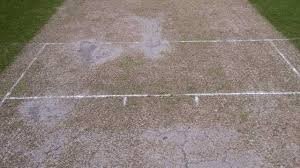
 |
| Index | |
|
|
|
|
|
| Pitch damage  Since most cricket is played on a natural, organic surface, with a ball that is itself made principally from organic materials, it follows that no two pitches will ever display exactly the same playing characteristics It also follows that any alteration to the surface of the pitch could have a material effect on the behaviour of a ball bouncing on it. Consequently the Laws state that deliberate damage to the pitch is an offence. It is regarded as unfair play - and hence penalised - if any player on either side deliberately damages the pitch. Good practical rules to minimise pitch damage are that the bowler must move off the pitch as soon as he can and certainly by the time his follow-through is complete. Indeed one area of the pitch, known as the Protected area (often incorrectly called the Danger area), is to be 'protected' by the umpires against damage by the bowler in his follow-through, the strides following his delivery stride. Fielders (and this includes the bowler once his follow-through has finished) must not be on the pitch except to field the ball, and certainly not to celebrate a dismissal or to discuss field placings. The striker, when running, must move off the pitch as soon as practicable and certainly before he completes his first run. Batters must not hold conferences in the middle of the pitch - the non-striker should never be on the pitch anyway! |
||||||